RELG 433 - Biblical Archaeology
Cource Notes
Module 8
The Late Bronze Age in Canaan, ca. 1,550 - 1,200 BC
Images in the text are linked to larger photos - click on them to see the larger pictures.
Hover the mouse over the images to see their captions and copyright credits.
 In Canaan
In Canaan
Egyptian domination
- Military campaigns and outposts.
- Payment of tribute by Canaanite city states to Egypt.
- Egyptian centers at Gaza, Beth-shean, Jaffa.
- Exports of wood, oil, wine, wheat, cattle, copper, slaves, concubines to Egypt.
- Records of city states at Lachish, Gath, Ashkelon, Ashdod, Gezer, Jerusalem, Shechem, Taanach, Megiddo, Hazor. Also at Tyre, Sidon, Beirut, Damascus.
- Trade between Egypt and Syria - building of ports along the Mediterranean coast.
- Incursions of "Habiru" or "Hapiru" - Hebrews ?, and "Shasu" - nomadic pastoralists.
- Gradual deterioration of society due to 300 years of Egyptian exploitation and domination.
- Devastation by wars between Egyptians and Hittites.
- Droughts throughout Middle East - leading to famines.
- Subdivisions of the Late Bronze Age correspond to various Egyptian Dynasties and their power in Canaan
However, the Canaanite culture did not change much from one subdivision to another. -
Timna'
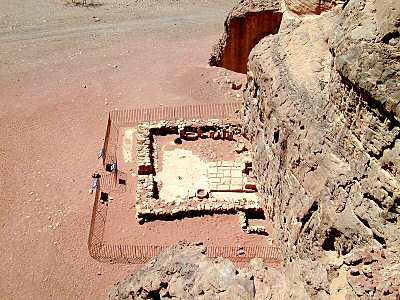
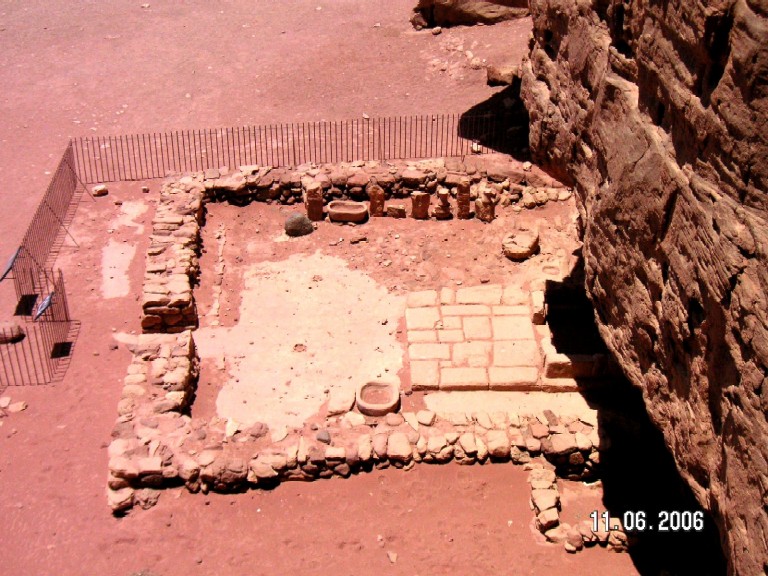
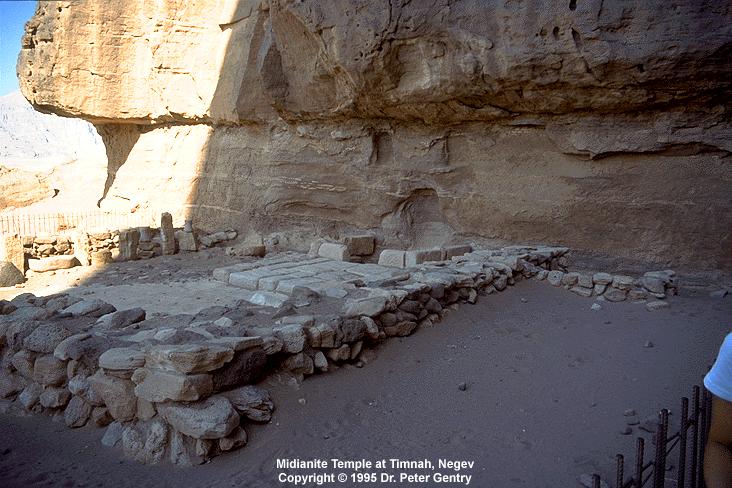
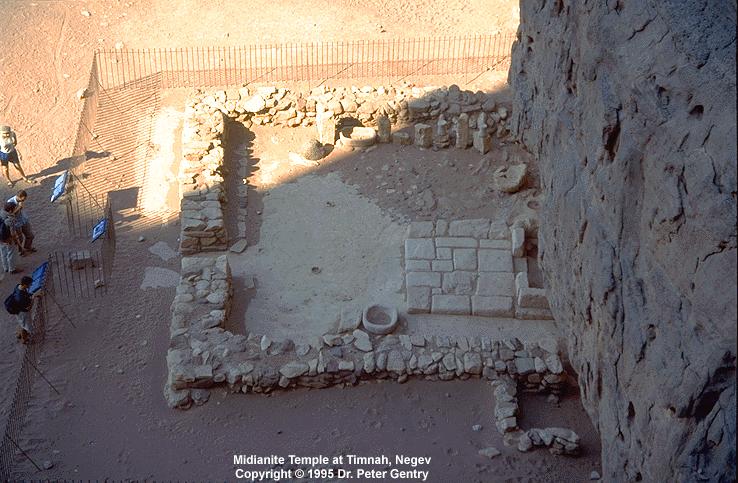 in the southern Arabah (NOT Timnah in the Shephelah) was a source of copper. Timna' is in the far south of the region, and was exploited by the Pharaohs of the Nineteenth and Twentieth dynasties.
in the southern Arabah (NOT Timnah in the Shephelah) was a source of copper. Timna' is in the far south of the region, and was exploited by the Pharaohs of the Nineteenth and Twentieth dynasties.
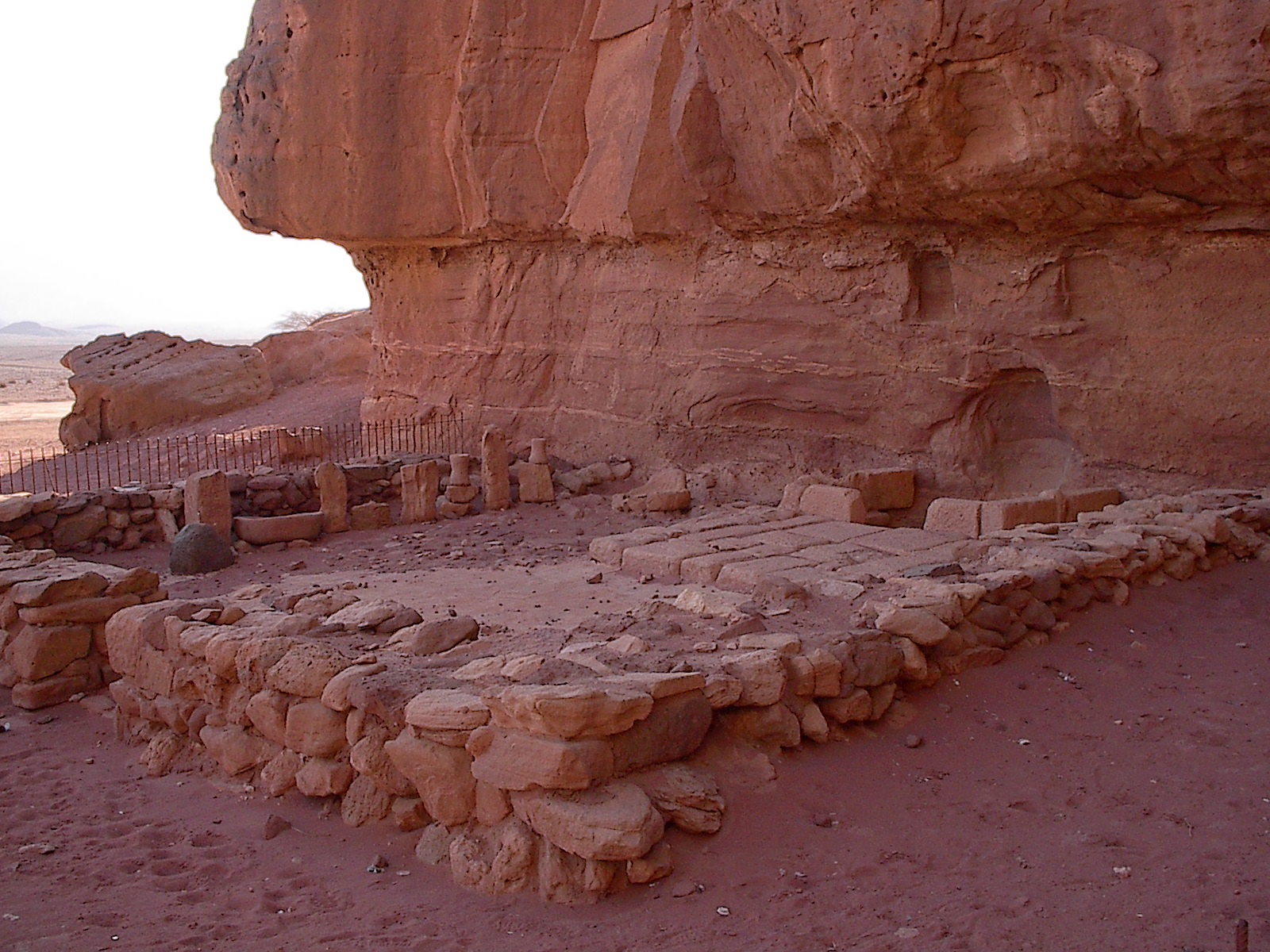
 The Egyptians built a shrine to their goddess Hathor, which in later ages became a place of worship for Bedouin tribes (hence it is sometimes referred to as a 'Midianite' shrine)
The Egyptians built a shrine to their goddess Hathor, which in later ages became a place of worship for Bedouin tribes (hence it is sometimes referred to as a 'Midianite' shrine)
Settlement Pattern
- Decline in population and in number of settlements compared with MB.
- Decrease in agricultural settlements, increase in nomadic pastoralists.
- Settlements along Mediterranean coast, for shipping and maritime trade.
- Many cities were destroyed and rebuilt several times, due to inter-city warfare.
- Towns had various street-patterns, cult centers - indication of various cultures - no longer homogeneous.
Palaces
- Palace and Temple were separate, indicating that there were different people as king and priest ?.
- Gradual development of palaces from square building - a courtyard surrounded by rooms on all four sides, to larger rectangular complexes, still with central courtyard, but with "reception halls", dwelling rooms, bathrooms.
Houses
- Rooms around or beside a courtyard.
- Staircases up to a second story.
- Large houses for wealthy or powerful people, indicating the development of different classes of society.
Temples
-

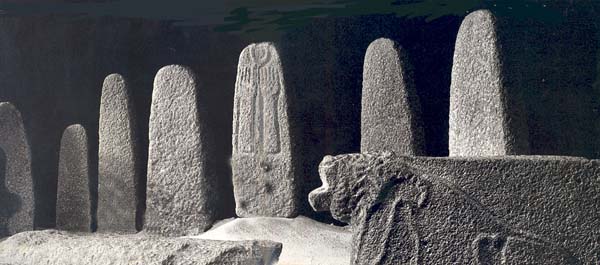 Cult places or shrines - with standing stones and altars.
Cult places or shrines - with standing stones and altars. - MB Temples were still used, and were renovated or rebuilt.
- Temples were large symmetrical building, entered from a porch in front of the main hall.
- "Holy of Holies" was inside the main hall, opposite the entrance.
Fortification
- Almost none, though MB gates and walls might be kept and repaired.
- Probably the Egyptians would not allow anything that might form a stronghold against them.
Pottery : Local and Imported
- Local Pottery
No distinct cultural break between MB and LB.
Gradual changes - became courser, rougher, mass-produced.
Decoration with red, or red and black, on buff-colored background - geometric shapes.
Bichrome Pottery : Decorated with red and black.
First appeared ca. 1,600 BC - late MB - and continued through 16th and early 15th centuries.
Mostly made with clay from Cyprus, though some was made locally at Megiddo.
Forms and decorations similar to local Syrian and Canaanite, but also with Cypriot influences.
May reflect a group of Hurrians or folk from Cyprus who either settled on the coast of Canaan or imported goods into Canaan.
- Imported Pottery
Cyprus was a center for trade in the Mediterranean.
Export of pottery from Cyprus to the Levant began in MB, continued into LB.
Pottery usually hand-made rather than on a wheel.
Various forms and types of decoration.
Imported luxury ware ?
Mycenaean ware - from Mycenae.
Made on a wheel, from fine clay.
Exported throughout the Near East.
Metallurgy
- Copper was exported from Cyprus.
- Later - 13th century - copper ores were mined along the Arabah.
- Tin from the north - Afghanistan ?
- Sites where metal working was carried out, eg in Sharon Plain - were associated with Cypriot pottery.
- Gold and silver become rarer - were they being sent to Egypt ?
Weapons
- Made of bronze (an alloy of copper and tin).
- Sickle-shaped scimitars.
- Daggers cast together as one unit with the handle.
- Spearheads, arrowheads.
- Also made chisels, cymbals, figurines.
Trade
- Cyprus was a center for trade - exported copper from Cyprus itself, and acted as a middleman between the Aegean and the Levant.
- Mycenae - trade in fine pottery. See links for the "Bronze Age Wreck".
- Egypt - goods sent by sea to the Levant, or along the "Horus Road" into Canaan.
Art
-
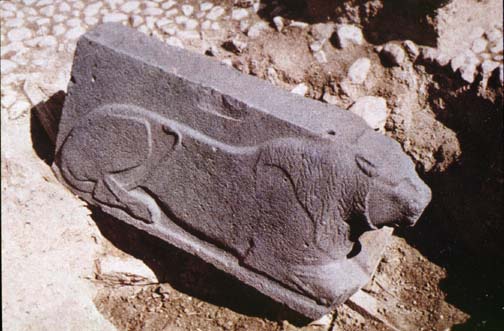
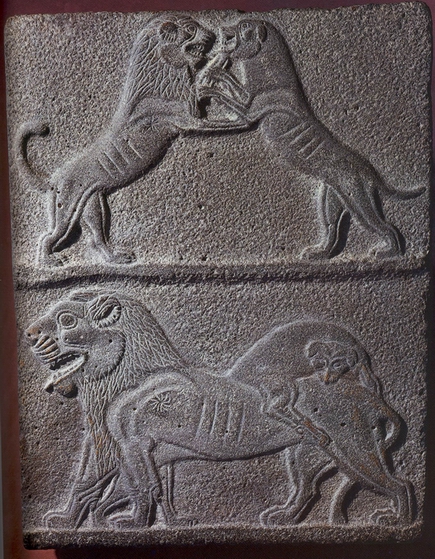 Stone sculptures : statues and reliefs of lions. Stelae of gods and people.
Stone sculptures : statues and reliefs of lions. Stelae of gods and people. - Metal - figurines of gods and goddesses.
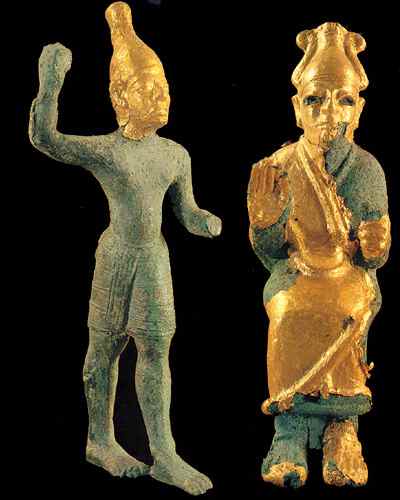
-
Ivories - carved pieces and inlays - imports and local artists adapting Egyptian and Mycenaean motifs.

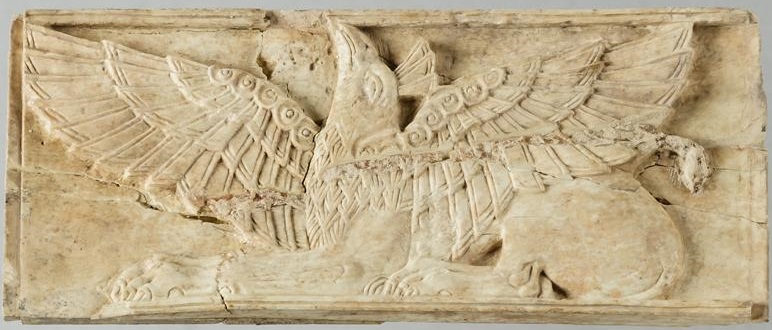
- Clay - pottery figures, mainly goddess figures.
- Cylinder seals - continuing tradition from MB.
- Egyptian scarab seals - due to Egyptian domination.
Writing
- Akkadian was still the language of diplomacy.

- Egyptian hieroglyphs - alphabet without vowels, written either left-right or right-left, words not linear but in rectangular blocks.
- Rulers employed scribes who were bi- or tri-lingual.
-
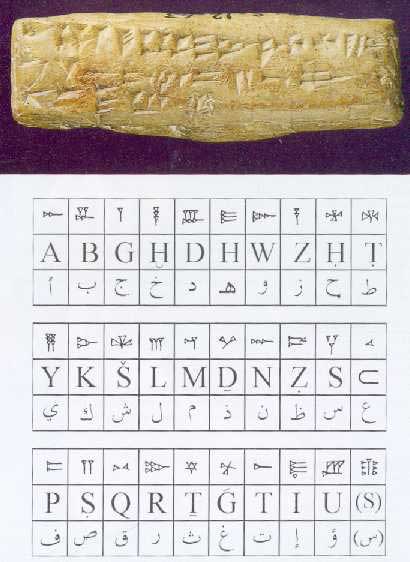 Development of the Canaanite alphabet was not controlled by religious authorities, so was free to develop and change.
Development of the Canaanite alphabet was not controlled by religious authorities, so was free to develop and change.
There were two separate forms of Canaanite writing
1. at Ugarit - system using 27 cuneiform signs, inscribed on clay.
The Ugaritic form did not develop or become very prominent outside Ugarit.
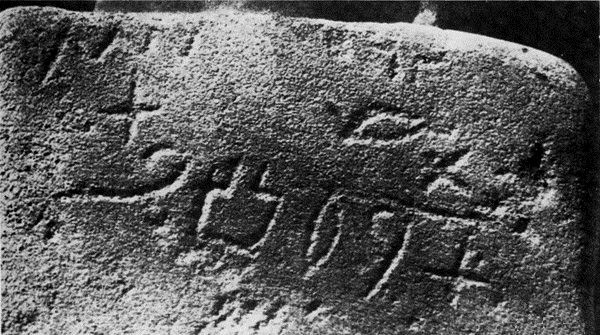 2. in Canaan there were several variations :
2. in Canaan there were several variations :
Proto-Sinaitic, found on rocks at turquoise mines in the Sinai.
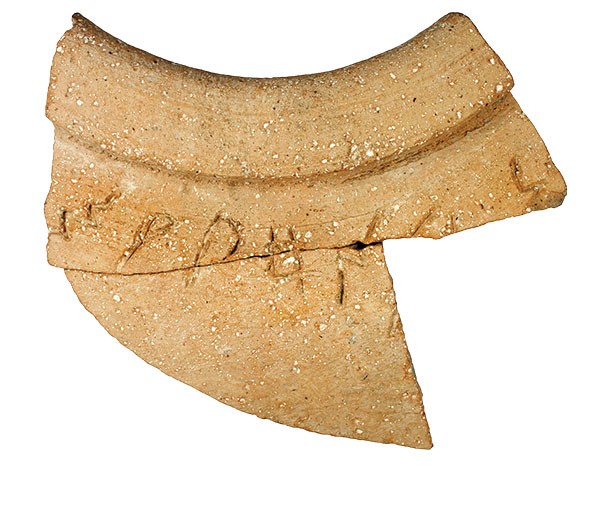 Proto-Canaanite, found in Canaan itself.
Proto-Canaanite, found in Canaan itself.
Burial Practices : Various, reflecting different cultural groups
-
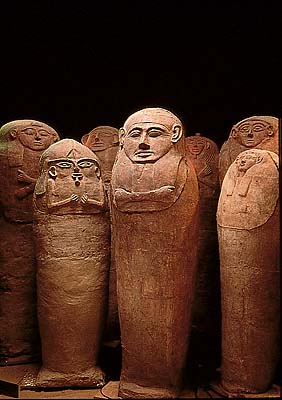
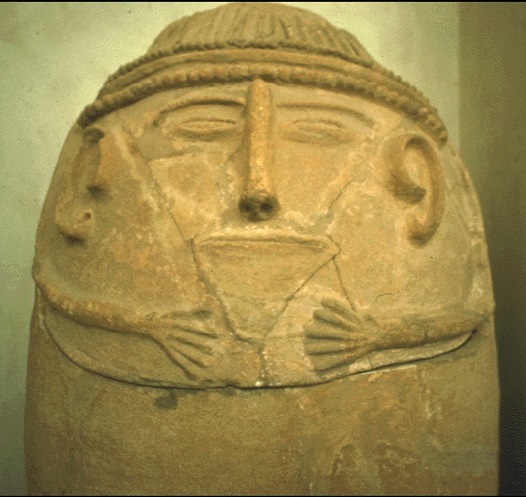 Anthropoid coffins - similarities to Egyptian coffins which held mummies, though the Canaanite version apparently held a body rather than a mummified corpse.
Anthropoid coffins - similarities to Egyptian coffins which held mummies, though the Canaanite version apparently held a body rather than a mummified corpse. - Central shaft with side niches.
- Caves, for multiple burials, with grave goods.
- Cemeteries with dug-out tombs for individuals.
These are found on the coastal and northern plains. - Dromos tombs, built of stone slabs, with a stone corridor leading underground to them.
Similar to Tholos tombs of the Aegean culture. - Cemeteries unrelated to a settlement - used by nomads ?
![]()
 End of the Late Bronze
End of the Late Bronze
Caused by the break-up of civilizations and of trade around 1,200 BC,
by the invasions in Greece, the fall of Troy, and the migration of "Sea Peoples" from the Aegean,
the decline of the Hittite empire, and the destruction of Ugarit.
Earthquakes and seismic activity may have been contributing factors.
In Canaan, some of the large cities were destroyed.
Copyright © 1999 Shirley J. Rollinson, all Rights Reserved